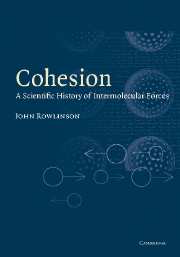4 - Van der Waals
Published online by Cambridge University Press: 27 July 2009
Summary
1820–1870
The half-century that followed the decline of Laplace's influence in the 1820s was an exciting if confusing time for both physicists and chemists. Laplace and his contemporaries had created many of the mathematical tools that would be needed by the rising generation of theoretical physicists but these tools were to be used in decidedly non-Laplacian ways in the flourishing fields of thermodynamics, optics, electricity and magnetism. The men who were responsible for these developments were mainly German and British; French influence declined rapidly from about 1830. An important early figure was Franz Neumann but it was the brilliant generation that followed who were to lead these fields – Stokes (b.1819), Helmholtz (1821) [1], Clausius (1822), William Thomson (1824), Kirchhoff (1824) [2], and Maxwell (1831) [3]. Some of the views that they were to articulate were held instinctively by Faraday [4], the modest but acknowledged leader of the experimental scientists. The physicists often maintained that every theory should ultimately be reducible to mechanics but they nevertheless created theoretical structures that did not lend themselves to such a reduction. The fertility of field theories led, in Britain at least, to a disparagement of theories based on action at a distance, but in Germany matters were less polarised. The influence of Kant's philosophy led Helmholtz in particular to retain this concept, and Clausius and Boltzmann were later to be equally happy with it, at least as a pragmatic basis for molecular modelling.
- Type
- Chapter
- Information
- CohesionA Scientific History of Intermolecular Forces, pp. 141 - 233Publisher: Cambridge University PressPrint publication year: 2002



